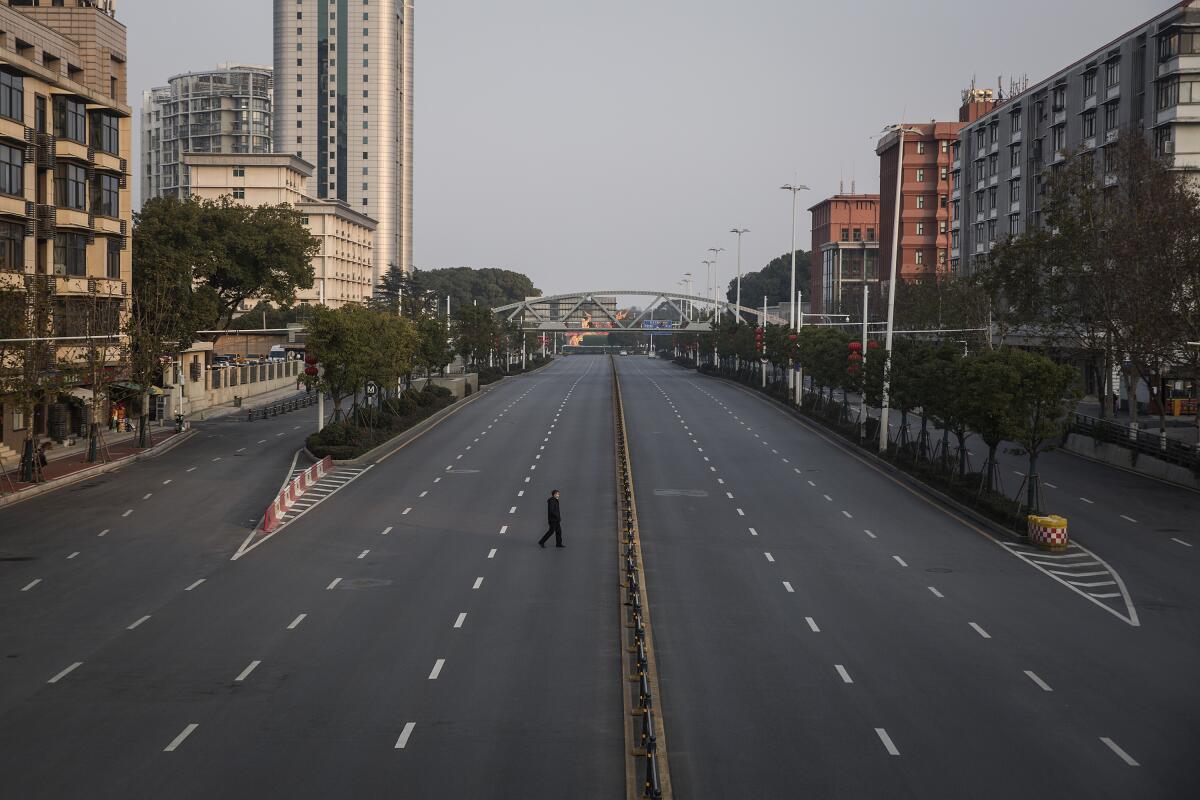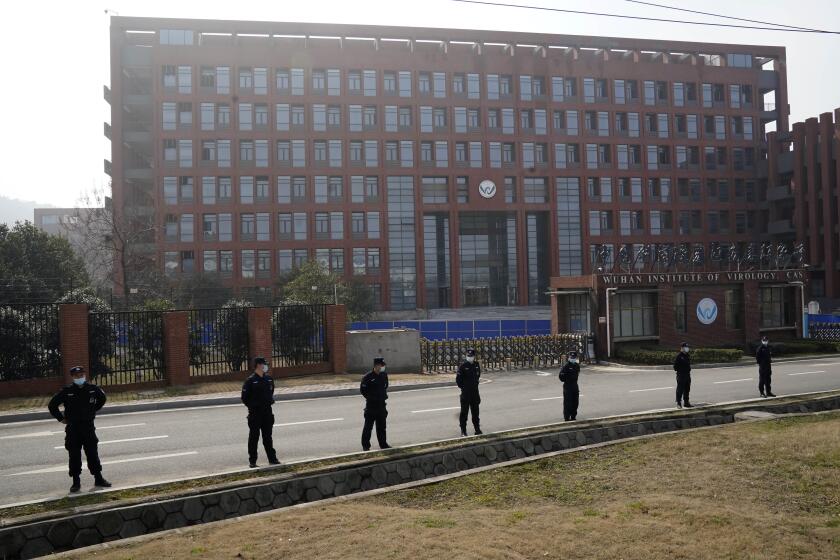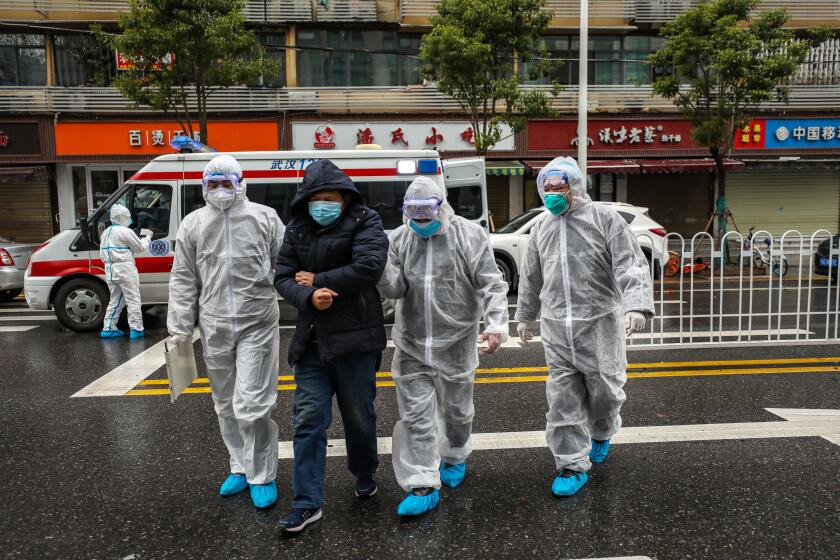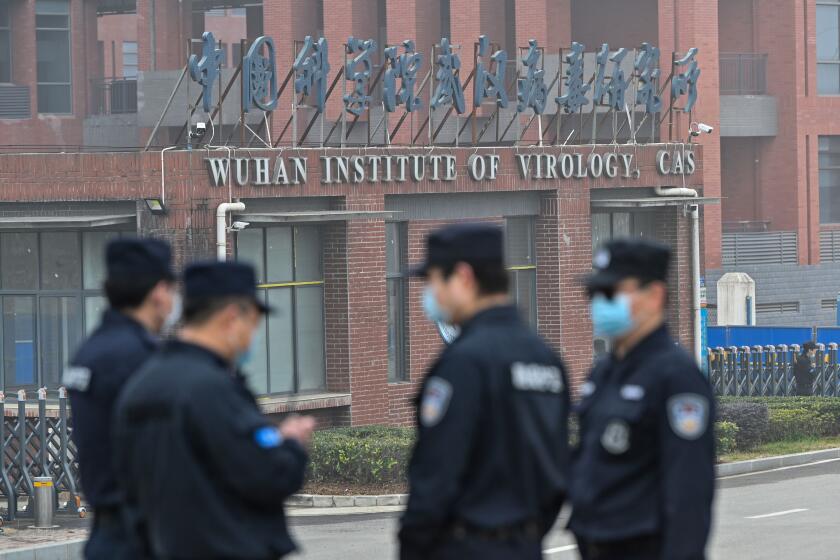Column: Contrary to latest claims, there’s still not a speck of evidence that COVID escaped from a Chinese lab

- Share via
We know that America is fascinated by zombies: “The Walking Dead,” “Fear the Walking Dead,” “Zombieland” and now — even though aficionadoes may split hairs over this — “The Last of Us.”
Perhaps that explains why a claim about the pandemic that has been consistently debunked by scientific experts and should have been buried long ago still walks among us. That’s the claim that the COVID virus escaped from a Chinese laboratory — specifically, a Chinese virology lab.
This zombie theory got another shot of life-giving plasma this weekend from the Wall Street Journal, which reported that the Department of Energy “has concluded that the COVID pandemic most likely arose from a laboratory leak.” The Journal also reported, however, that the agency “made its judgment with ‘low confidence.’”
Get the latest from Michael Hiltzik
Commentary on economics and more from a Pulitzer Prize winner.
You may occasionally receive promotional content from the Los Angeles Times.
If you’re confused about how a judgment made with “low confidence” can result in a conclusion that something is “most likely,” join the club. I’ll come back to that. But let’s start with the basics: There is no evidence — not a smidgen, particle, speck or iota — that COVID leaked from a lab. There never has been.
The virology and epidemiology communities, which base their conclusions on empirical data, overwhelmingly favor the conclusion that the pandemic originated in human contacts with infected wildlife, known as the “zoonotic” hypothesis. That’s how previous pathogens reached the human community, and the evidence that it has done so in this case is powerful and getting progressively stronger.
A blockbuster investigation by ProPublica and Vanity Fair claims COVID originated in a lab. Here’s where they went wrong.
Almost from the start, the lab leak theory has been reliant on conjecture and fueled by Trumpian ideology that has infected, like the pathogens in all those zombie movies and TV shows, the entire Republican Party.
For them, the claim that the pandemic escaped from a Chinese laboratory to infect the world is a convenient weapon to wield against China and perhaps hobble its ability to challenge America’s global economic primacy.
Congressional Republicans have been trying to stand this zombie on its own two feet for years. Serious journalists treat their claims with caution, but sometimes the temptation is overwhelming to break news, or at least what seems like news.
The independent investigative organization ProPublica stepped on this rake late last year, when it promoted the lab leak theory by relying partially on a report by the then-minority Republican membership of the Senate Committee on Health, Education, Labor & Pensions that asserted, again without offering a speck of evidence, that the pandemic was “more likely than not, the result of a research-related incident.”
After I and other critics pointed out the ludicrously weak underpinning of its article, ProPublica issued a wan correction. But it didn’t retract the piece, which would have been proper.
The Journal’s latest “scoop,” to cite the laudatory description offered by the newspaper’s own editorial writers, follows the pattern of all other lab leak claims reported in the news media. It reports no new evidence, only a purported change of tone in the Energy Department’s viewpoint.
The article is based on a classified document that the Journal acknowledges it hasn’t seen, the gist of which was retailed to the Journal by “people who have read the classified report.”
The Journal said the Energy Department based its ostensibly changed viewpoint on “new intelligence, further study of academic literature and consultation with experts outside government,” but didn’t describe that new intelligence, nor did it identify the academic literature or outside experts the agency supposedly used.
Column: A new research paper adds to the evidence that COVID-19 came from animals, not a Chinese lab
A new study supports the scientific consensus that COVID-19 reached humans from the animal kingdom, not a Chinese laboratory.
It certainly doesn’t sound as if the Energy Department had brought new empirical evidence to bear on the question of COVID’s origin.
What does the term “low confidence” tell us about the quality of the Journal’s “scoop”?
Here’s how the National Intelligence Council, the umbrella organization for the nation’s intelligence community, explained the term in 2017: “Low confidence generally means that the information’s credibility and/or plausibility is uncertain, that the information is too fragmented or poorly corroborated to make solid analytical inferences, or that reliability of the sources is questionable.”
That’s some recommendation!
Low confidence generally means that the information’s credibility and/or plausibility is uncertain ... or that reliability of the sources is questionable.
— National Intelligence Council
What’s plain from the Journal article is that the Energy Department’s judgment, negligible as it is, hasn’t materially changed the general assessment of the intelligence establishment of the U.S. government that the lab leak theory, as described in a declassified report issued in 2021 by the Biden administration, is dubious.
That assessment was the product of an inquiry by the members of the government’s “intelligence community,” including the Energy Department, that was ordered by President Biden.
The administration reported that four member agencies and the National Intelligence Council “assess with low confidence” that the zoonotic hypothesis was most likely; one (apparently the FBI) “assesses with moderate confidence” that the pandemic was the result of “a laboratory-associated incident” at the Wuhan Institute of Virology, which is located in the same city but a considerable distance from the wildlife “wet market” that scientists have identified as the epicenter of the first known COVID outbreak. Three other agencies took no stand.
On Sunday and Monday, other news organizations repeated the Journal’s purported scoop with varied degrees of credulity.
The New York Times acknowledged the Journal’s reporting with a healthy dollop of snark, quoting its own anonymous sources as noting that none of the other intelligence agencies changed their positions when confronted with the Energy Department’s assessment. Some of the newspaper’s sources described the new intelligence as “relatively weak.”
In ‘Viral: The Search for the Origin of COVID-19,’ Alina Chan and Matt Ridley ignore scientific consensus in favor of specious, dangerous guesswork.
NBC News, Bloomberg, Fortune and the Hill all reported the story, but laid it on the Wall Street Journal. That’s what you do in the news business when you feel obligated to acknowledge another news organization’s story but wish to signal that you don’t really buy it.
One question prompted by the Journal’s report concerns its timing. It comes just as the Republican majority in the House is gearing up to promote the lab leak theory. The onslaught is likely to start Tuesday, when a committee on China-U.S. relations headed by Rep. Mike Gallagher (R-Wis.) holds its first hearing.
Soon we’ll be hearing from the House select subcommittee on the coronavirus, which comprises quite the lineup of sober Republicans interested only in the truth.
Its GOP members include Rep. Marjorie Taylor Greene of Georgia, who was permanently suspended by Twitter last year after she falsely claimed that COVID was “not dangerous for non-obese people and those under 65,” that the COVID vaccines were “failing,” and that they caused an “extremely high” death toll. (Twitter’s new owner, Elon Musk, restored her account.)
Another member, Rep. Ronny Jackson of Texas, claimed that the Omicron variant of the virus was a Democratic hoax aimed at pushing mail-in ballot rules.
Then there’s Rep. Mariannette Miller-Meeks of Iowa, who falsely claimed that the Centers for Disease Control and Prevention were going to mandate the COVID vaccine for children (never happened), and Rep. John Joyce of Pennsylvania, who threw a fit over “vaccine passports,” which were always a right-wing fever dream.
Also on the committee are Republican Reps. Rich McCormick of Georgia, who claimed fancifully that masks are harmful to childrens’ health; and Michael Cloud of Texas, who has gone on record blaming the Chinese government for the pandemic.
The looming tsunami of GOP-driven publicity for the lab-leak theory makes the Journal’s would-be scoop appear exceptionally topical. That’s not a point in its favor. As John Le Carré’s fictional spymaster George Smiley observed in “Tinker, Tailor, Soldier, Spy,” the “impressive topicality” of leaked government material is always cause for suspicion.
That’s true in this case. Even the Journal’s editorial writers concede that the pending GOP committee hearings “may explain the timing and perhaps the impetus of the leak about the DOE judgment.” (The editorialists, oddly, seem to consider that a virtue, when it’s really a defect.)
Column: A declassified government report offers no support for the lab-leak theory of COVID’s origin
For months, adherents of the theory that COVID-19 originated in a Chinese government laboratory have hoped that an assessment President Biden ordered from the nation’s intelligence agencies would validate their suspicions. Their hopes are now dashed.
Among the giveaways that the Journal’s article is much weaker than it might seem at first glance is the curious torturing of the English language, including the juxtaposition of a “low confidence” judgment with a “most likely” conclusion.
Then there’s the downplaying of how little has changed in the overall assessment of the lab leak theory by the intelligence community. According to the original declassified version of the administration report: “Some analysts at elements [that is, agencies] that are unable to coalesce around either explanation also assess a laboratory origin with low confidence.”
That report didn’t identify which elements employed those analysts. Who’s to say that it wasn’t the Energy Department even then?
The Journal further asserts that “the Energy Department now joins the Federal Bureau of Investigation in saying the virus likely spread via a mishap at a Chinese laboratory.” That’s not quite true: The FBI has “moderate confidence,” in that conclusion, but the Energy Department has “low confidence.” That doesn’t sound like they’re necessarily on the same page.
Virtually everyone who has weighed in on the question of COVID’s origin observes that the answer is important to global public health. That’s because getting it wrong will mean the waste of precious resources on the wrong remedies, increasing the chance that yet another pathogen attacks the human community and leaves us without the weapons we need to fight it.
On one side of this debate is mounting scientific evidence pointing to the need to regulate contacts between humans and wildlife that appear to be reservoirs of dangerous viruses.
In the fullness of time, evidence might emerge that supports the theory that COVID escaped from a Chinese lab. All we have today is sophistry promoted by ideologues who have produced absolutely no evidence despite three years of trying. They’re playing a dangerous and shameful game.
More to Read
Get the latest from Michael Hiltzik
Commentary on economics and more from a Pulitzer Prize winner.
You may occasionally receive promotional content from the Los Angeles Times.















